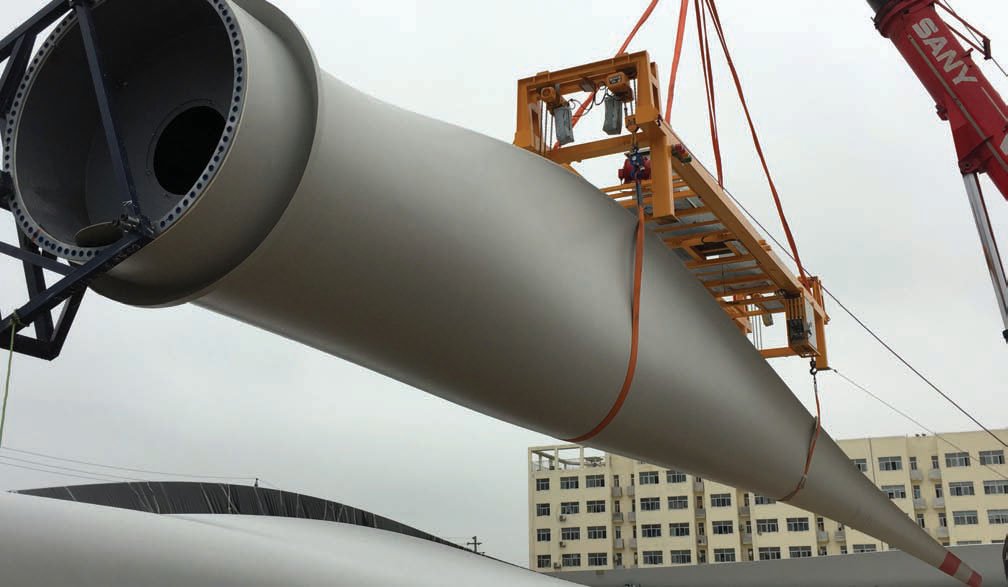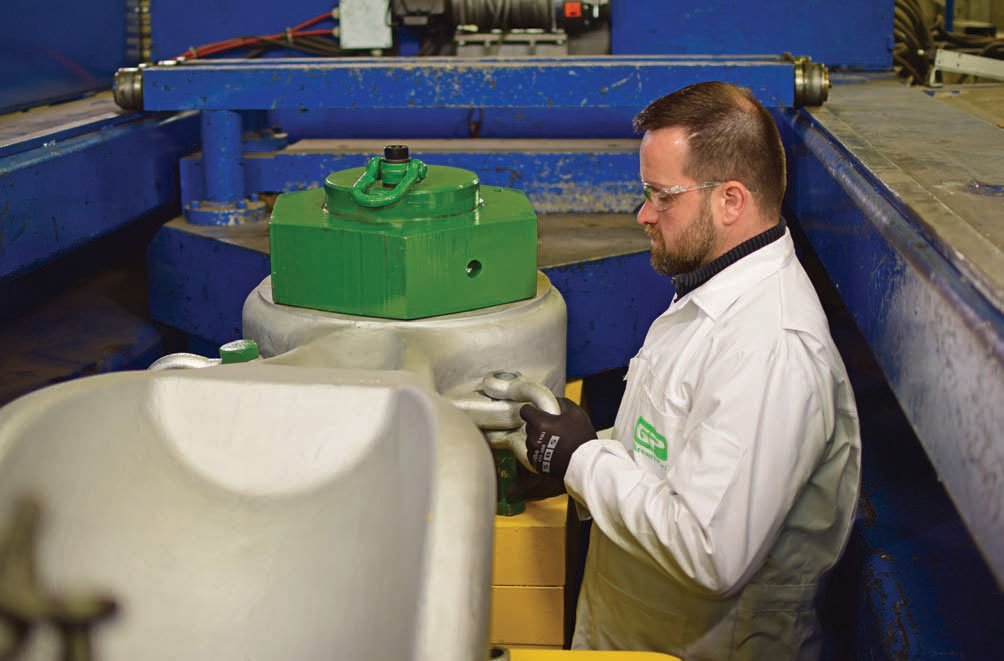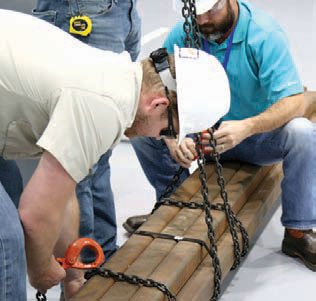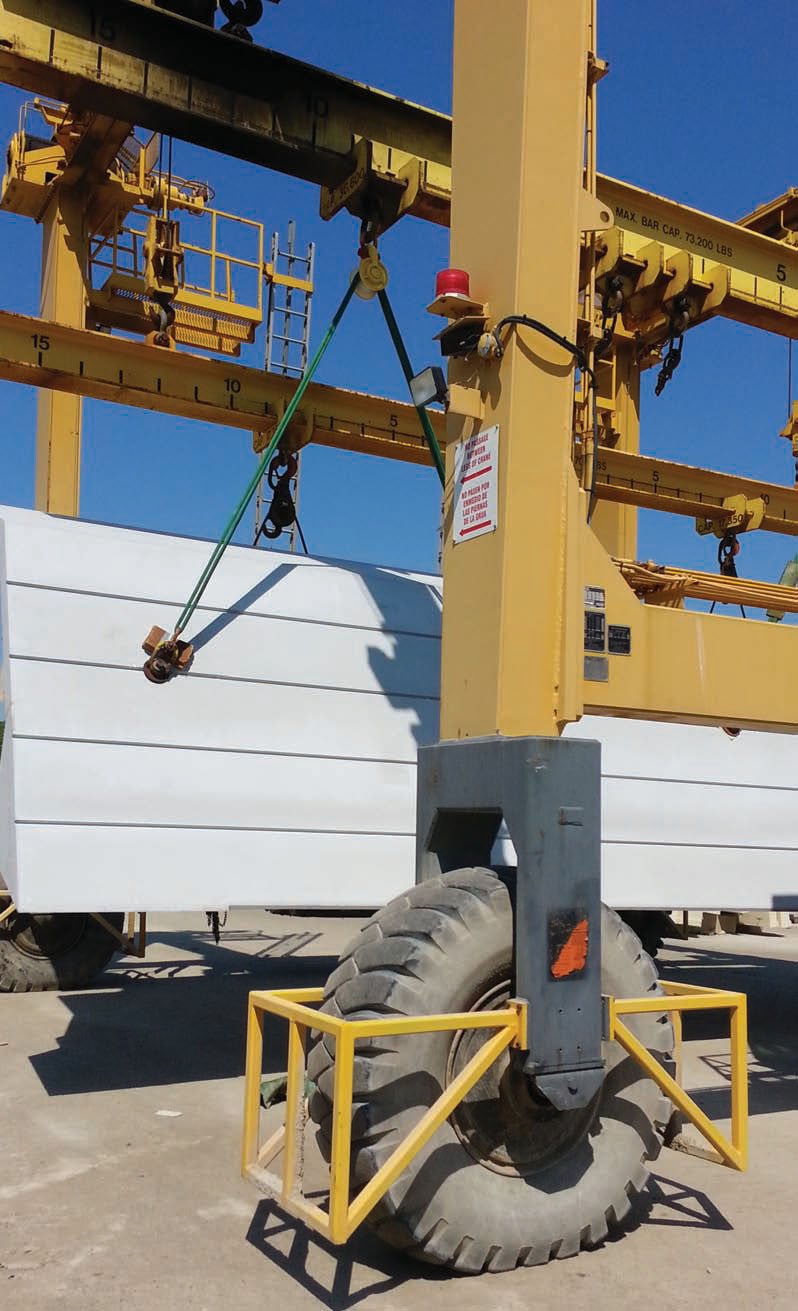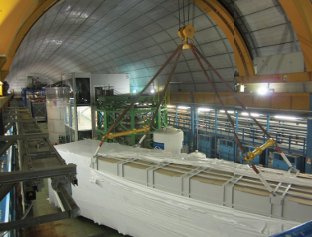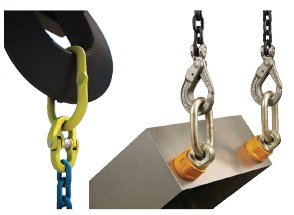Smart rigging
27 December 2017Paola De Pascali looks at the latest equipment used below the hook to assist with lifting, where the key demands are oriented towards smart features to enhance efficiency and safety.
Modulift managing director Sarah Spivey says the company has launched two products that can be utilised within a low headroom environment, the first being the off-the-shelf adjustable lifting/spreader beam.
“The MOD CLS is an adjustable lifting/ spreader beam which is unique to the market as it is stocked on the shelf in our warehouse ready for immediate shipping,” Spivey explains.
“Unlike many other alternatives that have to be designed and manufactured to order, which results in longer lead times for customers, the MOD CLS utilises a clamp system, giving our customers a safe, fast and adjustable beam, whilst also enabling users to lift from multiple points.”
The clamps can be pre-assembled on the beam and are provided with markers to show alignment and the centre of lift. Clamps on the upper or topside of the beam are of a larger rating and size than the two clamps fitted to the bottom or underside of the beam.
The MOD CLS can be also adapted to suit with up to an additional four clamps on the bottom side of the beam allowing users the flexibility of additional lifting points, and is currently available in one size, of 8.5t capacity.
“The second product that Modulift offers is the CMOD Spreader Frame, which has multiple lifting points in a square or rectangular format,” Spivey says. “The Modulift CMOD Spreader Frame is an ideal solution when headroom is limited and is designed for where there are height restrictions, as the height of the rig will be lower than a ‘1 over 2’ configuration.”
The Frame is designed to expand the capabilities of the Spreader Beam system as the struts from Modulift Spreader Beams are combined with four corner units to complete a frame, therefore saving costs for existing Modulift customers.
Currently sizes are available up to a CMOD 250 system, which can lift up to 300t. Modulift works worldwide on a variety of lifts and has recently heavily invested in its engineering team, as there has been an increase in demand for engineered lifting products.
“Modulift has a specialist department who deal with custom designed manufacturing requests. Rig design is becoming a more frequent requirement from customers,” Spivey says. “Modulift works with OEMs across all industries including oil and gas, offshore, nuclear, marine and many more.”
In 2015 the company worked closely with Switzerland-based scientific research facility Cern to offer a CMOD solution for an in-door lift where headroom was limited. “Modulift was tasked with lifting a physic neutrino detector. At a weight of 40t this delicate apparatus was not only very fragile, but also incredibly valuable,” Spivey says. “In fact a cool £350,000 worth of equipment was being lifted in one hoist, measuring at approximately 4mx4m, with an overall length of 20m.
“Modulift prides itself on designing quality assured spreader beams with the upmost precision, exacting standards and functionality, which contributes to a safe, stable and consistent lifting procedure. Thus proving that Modulift aims to excel in accordance with their own risk management criteria, globally awarded certification and ultimately providing ‘universal’ lifting solutions.”
Hope Pearce, junior design engineer for Modulift said, “It’s a pleasure to be working with an organization of CERN’s stature, and it’s a testament to the quality of Modulift equipment that it is fit for use in such critical lifting applications. We are looking forward to what challenges we can help them with in the future and hope to continue to facilitate their lifting requirements for a long time to come.”
Columbus McKinnon has been designing and manufacturing for 140 years hoists, actuators, cranes, and lifting and rigging tools. Michael Osborn, global product manager for chain and rigging products explains that Columbus McKinnon is a global company with most of the manufacturing completed in the United States.
“We offer a broad range of rigging products used in manufacturing, construction, transportation, forestry, utilities and other industries,” Osborn says. “The company has recently introduced a complete line of Weblok connector assemblies. These new assemblies facilitate lifts made with synthetic slings, and allow these synthetic slings to be connected to master links and other rigging hardware.
“Columbus McKinnon has improved these products over others on the market by designing them to have, in some cases, higher Working Load Limits than the others. Webloks are forged from high strength steel, where others may be castings. Additionally, Webloks have a double retention system for added safety. Other recent products include our larger 30t and 60t rigging hooks to satisfy the needs of our users.”
Amongst the recent projects, Osborn says the Columbus McKinnon Webloks would be a good example of how they respond to the needs of our users. “Ford Motor in Detroit requested them and as we offer this type of product with double retention. CM responded where our competitors would not,” he adds.
Headquartered in The Netherlands, Van Beest develops its products for offshore and onshore applications in industries such as oil and gas, construction, marine transport, renewables and all types of manufacturing plants and distribution centres.
“We have offices in Germany, France, Norway and US, and stock-holding distributors are in more than 90 countries worldwide,” says Roan Retera, Van Beest marketing manager. “Our end users are extremely varied but our core is the onshore and offshore Transportation and Installation industry, notably Engineering, Procurement and Construction (EPC) companies.” Talking about new products, Retera explains that their biggest brand is Green Pin, which has recently introduced the Power Sling Shackle.
“For this product, we decided not to focus on creating less costly products, but rather to develop a new shackle from scratch that unlocks much larger savings in its application; wire rope used in a sling can cost ten times more than a shackle,” Retera says. “At the same time, we wanted the new shackle to provide extra features that help the rigger to do the job safely and efficiently. The result was a product with many improvements. Users can save up to 20% on synthetic and steel wire rope costs due to the unique shape of the shackle crown, which can be more than 10% wider than the previous generation. The Power Sling’s shape—the D/d ratio of the shackle crown—enables a lighter steel wire or synthetic rope to be used than before, leading to significantly lower costs. “As regards the ease and safety of handling for riggers, the shackle is equipped with eight handling points to the body and several more on the pin. Many such handling points are smaller shackles that are attached to the main shackle body. Moving the shackle, which can weigh up to 2950kg, into place and attaching the load becomes much safer as a result. The design of the bolt is also new: it does not have any thread so it reduces the risk of cuts.
“The Green Pin Power Sling is available in a range from WLL 125T to 1250T.” Van Beest has also recently acquired the Norwegian company Load Solutions, the maker of Tycan. “Tycan is an innovative high performance chain made of Dyneema fibre,” Retera says. “It’s eight times lighter than steel chain yet just as strong. It is extremely safe to use, non-corrosive, nonconductive, completely waterproof and it floats on the water surface.”
Claes Sörebo, product and marketing manager at Gunnebo Industries explains that the company has a long reputation of successful inventions to the lifting and rigging industry. “Some examples of this is the coupling link, safety hook and insulated swivel,” Sörebo says. “Gunnebo Industries is a global leader in innovating, developing, manufacturing and selling products for material handling and other related applications. We supply the market with products such as blocks, sheaves, components for chain and wire rope slings, shackles and chain, produced in Sweden, Norway and USA. We have ten sales offices covering every continent, as well as partners and distributors in an additional 50 countries, making our products available no matter where in the world they are needed.
The quality of our products and expertise ensures a safe and efficient operation, every time during all circumstances. “We are involved in most types of industry segments. We supply all kinds of lifting products for use offshore and onshore, but also to land based drilling in North America. Other applications include building and construction, mining and steel industry, fishing, aquaculture and general industry.”
Looking at their more recent product news and innovations, Sörebo mentions the DNV 2.7-1 type approved master links for lifting offshore containers.
“We have launched an extended range of master links that have an extra resistance to hydrogen embrittlement and thereby increasing safety when used in tough and cold climates,” Sörebo says. “Other important innovations for the oil and gas segment is our new ROV retrieve shackle, for easy retrieving and releasing when lifting subsea as well as our double latch self-locking hook for increased safety on offshore platforms.” For general industry and building and construction, Sörebo highlights a couple of other products, “Hybrid master link, for perfect fit on DIN crane hooks that is one of the most common hook type on mobile cranes. The hybrid master link gives a perfect fit between the crane hook and the master link, which significantly reduces the wear on the expensive crane hook. We also have our Mid Grab Shortener, MIG. This tool makes it possible to shorten any short link chain even if it is already in service. It is a stand-alone component that can be retrofitted to increase the operational efficiency.”
Richard Oldknow, vice president of sales at Taiwan-based manufacturer of industrial safe lifting components Yoke Industrial Corp, explains that the company has recently launched the Super Point, which is a total solution for complex lifting, turning, rotating and tilting.
“The Yoke 8-251 Super Point is an addition to its range,” Oldknow says. “Allowing users to efficiently design their molds, dies and other mechanical lifting devices without losing valuable space to fit the lifting points.
“Yoke’s engineering has developed an extremely compact, high performance Super Point with a capacity up to 50t WLL (M100). It is also available in UNC up to 3.5ft and offers the capability to maximize their operations with one single design.”
The Super Point offers a versatile lifting point available in 48 variables—M10 through to M100, with UNC thread also available—enabling users to choose one compact design for all your lifting requirements. One single Super Point can lift up to 50t and it’s easy to handle being manufactured from forged alloy steel.
“Amongst the main advantages to enhance safety, you can find a 360° rotation and 230° pivot; a rotatable under load due to its unique ball bearing design; both internal and external surfaces are protected against corrosion by trivalent chromium plating; and an easy-to-measure disposal stage by using with the new dimension tables.”
Yoke has also expanded its range of wire rope and chain accessories with the new DA808 G8 and DA838 G6 closed die forged heavy lift shackles, used extensively in the oil and gas, subsea, vessel building, construction and energy markets.
Steven Hong, chairman of Yoke says: “In the current economic climate companies are challenging their procurement processes to review costs versus specification, they are seeking new partners who can provide products with competitive costs without sacrificing quality.
“You can’t continue to do the same things and expect different results. This has led Yoke to be met with increased demands for our heavy lift products, crystallizing our NPD process to ensure we get the key products to market at the right time.”
The Heavy Lift shackles DA838 (Grade 6) and DA808 (Grade 8) are closed die forgings to ensure the performance characteristics and clear embossed markings demanded, for ease of identification for years to come. “These markings have become the rigger’s choice, and offer you the assurance you need from a forged shackle,” Oldknow says. “Yoke DA heavy lift shackles also exceed the requirements of the European Standard (EN13889), USA Federal Specifications (RR-C-271F Type IVA Grade A and Grade B, Class 3) and other international and national standards. Many end users now insist on Yoke close die forged shackles over casting and upset shackles.
“Yoke DA shackles are clearly embossed with the Yoke brand, WLL, size, traceability code, grade and CE mark. The bolts are also embossed with the Yoke logo, traceability code and grade. Each shackle is hot dipped galvanized to ensure performance in the harshest conditions.”
Yoke has also introduced a new lightweight, user-friendly, high WLL chain sling design. The GrabEX100 is made from quenched and tempered alloy steel and manufactured in accordance with EN 1677-4 and ASME B30.26. Each link is marked with batch number that links to the test certificate with full traceability to raw materials. It provides a fully integrated shortening clutch and master link and a cost effective compared to slings that use multiple components.
“Our focus is on the environment, including cold temperature, dynamic loads and general safety for handling,” Oldknow says. “We aim to design new products with new materials and a lightweight design. We are also the first and only company to have the DNV 2.7-1 approval on the hooks and lifting points. The DNV GL 0378 is very topical today in the energy sector.”
Yoke applications include oil and gas, subsea, renewable energy sector, mining, and marine sectors. “The main end users include Toyota in Japan, Caterpillar in Thailand, Subsea 7 in the UK, Siemens in Germany,” Oldknow says. “Our major areas of business are in North America, China, and Europe.”
Oscar Fillol, CEO at Elebia explains that the company has recently launched their biggest automatic hook, the evo25, with the same features as the rest of the range of automatic safety hooks. It has a capacity of up to 25t and allows the operator to remotely attach and release loads with no handling, increasing safety and productivity. “Our hooks are available with a Heat Shield that protects the automatic hook and all its electronic components from radiated heat and extremely elevated temperatures, and we have designed the Bumper, which is the newest accessory for our evo2 to evo20 range of automatic hooks,” Fillol says. “The Bumper is a perfect shock absorber designed to protect the automatic crane hooks from impacts, scratches and especially day-to-day wear.
“We have also introduced new features for our eMAX remote control which enhances its use, such as an optional RS-232 serial port for PLCs, real time input and output data/orders transmission, and we’ve increased the range to up to 650m, amongst other new features.
“The innovative position encoder has been integrated into our automatic hooks representing an added safety element in all lifting operations. The position encoder is a technical upgrade of our remote hooks, as it allows the operator to know the exact angular position of the hook at any given moment thanks to the information relayed to the eMAX remote control. This important feature comes in very handy in operations where the operator can’t see the hook’s position. The automatic hook’s status is displayed on the eMAX remote control, transmitting real time information to the operator.”
The Elebia automatic hooks’ design is found to comply with DNV Standard for Certification No.2.22 Lifting Appliances, meaning they can be installed on all vessels classed by DNV GL.
Elebia has 85% of sales targeted to export. “The major areas include Europe, US, Australasia, Argentina, Russia, Canada, Vietnam, Romania and Morocco,” says Fillol. “Our end users haven’t changed in these 10 or more years and in any market where you have to work at elevated heights, with extreme temperatures or radiation and other difficult situations we have a strong demand for our automatic hooks.
“Applications include steel mills, windpower, turbines, ports/stevedore, nuclear, mining, construction. Over the last couple of years we have delivered our automatic hooks to a number of worldwide industry-leading companies for projects like the dismantling of Fukushima nuclear plant in Japan, steel bundle manufacturing in Canada, companies from the wind and energy industry such as Envision in China, Siemens in Denmark, Vestas in the USA, a joint project with XFactor application in the USA, LafargeHolcim cement production in the Philippines, and Valmont Structures in the US amongst many other clients. All this without forgetting the continuous collaboration with customers like Boeing, SpaceX, Rolls-Royce, and Michelin.”
Slingmax Rigging Solutions has introduced the Synthetic Equalizer Block, a specially designed rigging device for use with Slingmax Twin-Path highperformance synthetic fibre roundslings.
The block is used to maintain tension on all legs of a sling during a lift and will automatically adjust itself when pressure is put on the device, equalizing the load on any pick point. This also makes the block an ideal tool for adjusting from horizontal to vertical planes.
John Ketchum, vice president at Slingmax Rigging Solutions, explained the need for this type of device.
“Synthetic roundslings are commonplace in rigging today. The equalizer block is a newly patented product designed with Twin-Path synthetic fibre roundslings in mind. It is new to the industry and is being well accepted by those are requiring a lightweight device for equalizing loads. It is also ideal for use in tilt-up applications, such as those found in precast panel construction and installation.”
The blocks are available in 10, 25, 50 and 75 USt capacities, as well as 125mt capacity. The block features a steel frame with a polymer sheave and is designed specifically to work with the profile of the Twin-Path sling. The bail is designed to work on both the bow and the pin of a shackle, and the device is manufactured at a 5:1 design factor, unlike wire rope blocks which are manufactured at 4:1.
“We go to market through a network of manufacturing dealers and currently are represented by 37 dealers who manufacture our products worldwide,” Ketchum says. “We have representation in the United States, Canada, Mexico, Peru, Norway, Italy, Australia, UEA, India, Hong Kong, Japan, and Singapore. Each dealer manufactures our custom sling products and we distribute the Equalizer Block through this network.”
Some of the recent projects where the Synthetic Equalizer Block are being utilised include the Hudson Yards project in New York City and the Pennsylvania Turnpike highway systems in Philadelphia.
The precast concrete girder in the Pennsylvania Turnpike project had lifting points that were not equally spaced, nor did they have the same height. The girders were also extremely cumbersome, measuring 76m in length and weighing over 125t. Two cranes were required for each pick because of the length of the beam and the tight working spaces.
“Traditionally riggers would equalize the load using equalizing thimbles with wire rope slings or turnbuckles, which can be extremely heavy and difficult to work with,” Ketchum says. “The decision was made to use Slingmax Synthetic Equalizer Blocks on this jobsite because the crew preferred to work with lightweight Twin-Path slings. Due to the light weight of this rigging gear the crew was able to perform each operation in half the time it would have taken had they used wire rope slings and hardware.”
Frederik Stuart, senior project manager at construction services company PKF – Mark III, which is assisting the Pennsylvania Turnpike project, considered steel equalizers and equalizer plates but preferred synthetic round slings. “We wanted to utilise synthetic rigging because it is so lightweight for its capacity, and it is a lot easier for the guys to work with,” Stuart says. “We couldn’t find anything that would work as an equalizer with synthetic slings before Slingmax offered the Equalizer Block. Without it, the options were limited on using synthetic slings. It really just opens the door to opportunities with the lightweight synthetics. Our guys in the field would much rather use a synthetic that they can throw over their shoulder as opposed to a heavy steel choker that you need a crane to move.”
Hudson Yards is a $20bn development of new office, residential and retail space that is being constructed in Manhattan, New York. The majority of the lifts for Phase One consisted of installing ‘A’ frame supports, which would ultimately support an upper platform above 30 active railroad tracks at Hudson Yards. Each support column consisted of two sections, each weighing 45t. The support sections were brought on trailers in a horizontal position and the Slingmax Synthetic Equalizer Blocks were used to easily lift the columns into a vertical position to be welded together. They were then, lifted as a whole and placed between the railroad tracks.
